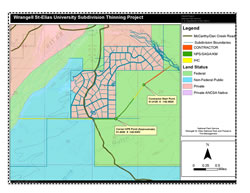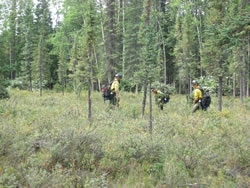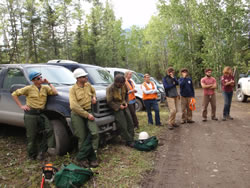National Cohesive Wildland Fire Management Strategy Success Story
Alaskans Create Fire Break to Protect Community of McCarthy
Wrangell-St. Elias National Park and Preserve, Alaska
Cohesive Strategy - Fire-Adapted Human Communities
2011

Map of Wrangell-St. Elias National Park fuels project.

Chena Hotshots remove brush to reduce the fire risk around McCarthy. NPS Photo.

Partners gather up at the end of the day for an after action review. NPS Photo.
Residents of McCarthy, a remote community within Wrangell-St. Elias National Park and Preserve (WRST), had an eye opening experience when the 2009 Chakina Fire burned more than 50,000 acres and advanced close enough that ash and embers fell on the community. Nearly a century had passed since a large wildfire had burned in the basin but an accumulation of beetle kill and mature vegetation made the area ripe for a lightning strike.
While the memory of the Chakina Fire was still fresh for McCarthy residents, the National Park Service (NPS) conversed with the community about creating shaded fuel breaks that could provide a buffer between burnable vegetation in the park and the town of McCarthy. The buffer would also include natural fuel breaks, the Kennecott River and McCarthy Creek, and the woody debris would be stacked in piles and burned at a later date. The timing of the conversations was right and locals liked the idea.
NPS Eastern Area Fire Management, the program that oversees fire management activities in WRST, engaged the Bureau of Land Management (BLM) Alaska Fire Service, Southeast Alaska Guidance Association, Morrison Construction, and the State of Alaska as collaborative partners in the project. Eastern Area Fire Management staff partnered with the BLM Alaska Fire Service Midnight Sun and Chena Hotshots. The Southeast Alaska Guidance Association, a non-profit organization dedicated to youth whose mission is to improve lives, lands, and communities in Alaska through service learning, provided a service corps crew of eight. The McCarthy Fire Department recommended that some of the work be contracted to Morrison Construction. Eight employees from the local forestry, landscaping, and log home construction firm joined the firefighters and SAGA crew. The State of Alaska contributed to the project by permitting the fuel break across state lands. And on August 22, 2011 crews began the 60-acre thinning project.
James Savage, Eastern Area Fire Management Officer stated, “Partnerships made this project a success. The community wanted to see locals working on the project and the NPS coordinated closely with our partners to create economic opportunities for residents especially because this project was located in their backyard.”
By the end of the first day, crews had completed several project acres and stacked more than a 100 piles. The crews worked hard and completed the three year project in a mere two weeks.
“Thanks to willing partners and proactive residents, in record time the wildfire risk to McCarthy was lessened. Removing hazard fuels reduced the likelihood of future large destructive wildfires and associated costs in the area, improved firefighter, and public safety and helped to restore forest health” said James Savage. The WRST hazard fuels project exemplifies a proactive, cost effective, collaborative approach to reducing the wildland fire risk to a community.
Contact
James Savage, Eastern Area Fire Management Officer
Email: james_savage@nps.gov
Phone: (907) 455-0650
Keywords: Youth, economic opportunities, use of a contractor, partnerships